

Q&A: Ray Kelvin - Founder & CEO - Ted Baker - Retail Focus - Retail Blog For Interior Design and Visual Merchandising. Details 10 Dec Written by Gemma Balmford.
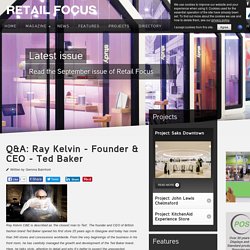
Whistles conquers the 'middle market' of British womenswear. While Marks & Spencer announced a 6.8% drop of general sales last month, another corner of the British high street has been quietly flourishing.
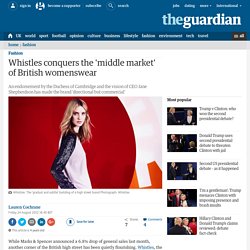
Whistles, the clothing brand set up by Lucille Lewin in the 1980s, announced this week that it had bought back the majority of its shares from the Icelandic government, a move which has underlined its growing strength. Whistles, which has been independent since parting ways with the retail group Mosaic in 2008, has gone from strength to strength despite a tough economic climate. Sales were up 13% in 2011 and there was "consistent double digit like for like sales growth," this year, according to a company statement.
Andy Murray's wife Kim wears Ted Baker dress to cheer on Wimbledon quarter-finals match. Major Retailer Analysis: All Saints. The high price of High Street chic: A £250 jumper. Winter coats for £1,250. Why have our chain stores become so absurdly expensive? A £250 jumper.

Winter coats for £1,250. Why have our chain stores become so absurdly expensive? By Marianne Power for MailOnline Updated: 01:14 GMT, 14 November 2011. High-end High Street - Linney Overview. The Store of the Future. LONDON, United Kingdom — “The Internet has become extremely good at doing what stores traditionally did: merchandise products, convey product information and process purchases,” says Doug Stephens, retail industry futurist and the founder of Retail Prophet.
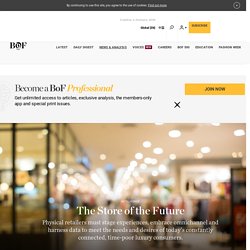
Indeed, e-commerce’s share of the shopping pie is growing. From 2000 to 2015, e-commerce jumped from 2 percent to 10 percent of all US retail sales. In the luxury sector, e-commerce is the only channel currently growing double digits and is expected to climb from 7 percent to 20 percent of global luxury consumption by 2025, according to Bain & Company. But unlike music, films or food, fashion is a product many shoppers want to touch and try on before they buy. The physical fashion store isn’t going away — but it is changing, as retailers come under pressure to provide consumers with personalised, data-driven service, and experiences — not just products — across all platforms. Experiential Retail. The High-End High-Street Brands To Luxe Up Your Wardrobe.
As much as we love a good bargain, sometimes it’s nice to really splash out on a proper investment piece and for this, we turn to the higher end of our Great British High Street.
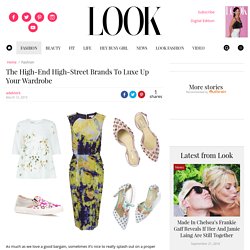
So here’s the lowdown on our fave high-end high-street brands who really spruce up our otherwise thrifty wardrobes. Whistles. How Tommy Hilfiger Is Rewiring For Fashion Immediacy. NEW YORK, United States — “In the 40-some years I’ve been in business, I’ve always been inspired by pop culture from the aspect of fashion, art, entertainment and, today, social media and celebrity,” says the designer Tommy Hilfiger.
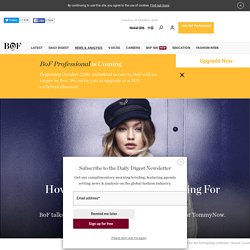
“Those are the drivers that our company is fuelled by. It’s really about listening to the consumer and being able to mold and shape our business around consumer needs through pop culture.” The 10 Commandments of New Consumerism. LONDON, United Kingdom — For decades, a brand’s only priority was to create the best possible product at the most competitive price to ensure sales.
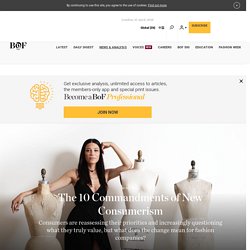
But as consumers develop a more comprehensive understanding of issues like sustainability, authenticity and transparency, brands and retailers are being forced to change the way they sell in order to survive. This change in consumers’ attitudes has a term — “new consumerism” — coined by research firm Euromonitor. “[Its] about today’s consumers reassessing their priorities and increasingly asking themselves what they truly value,” says Sarah Boumphrey, Euromonitor’s global lead of economies and consumers. How high-end fashion went virtual at Ted Baker. Brands the world over are facing a tech dilemma.
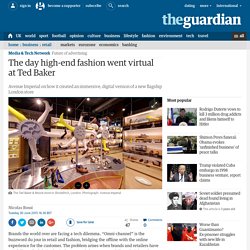
“Omni-channel” is the buzzword du jour in retail and fashion, bridging the offline with the online experience for the customer. The problem arises when brands and retailers have carefully crafted their physical stores and showrooms to deliver their brand experience, but for their online presence find themselves confined to the trappings of a 2D product catalogue.
This isn’t to say that the e-commerce catalogue is a bad thing, only that there are obvious limitations to selling products (particularly in the luxury and lifestyle spaces) via a 2D product catalogue. Hugo Boss Unveils First See Now, Buy Now Product. Hugo Boss Unveils First See Now, Buy Now Product (14 September 2016) At the label’s runway show in New York on Wednesday, Hugo Boss unveiled its first “see now, buy now” product — the Boss Bespoke Soft, a hand-painted leather bag inspired by David Hockey and available in four colours, which went on sale immediately after the runway show in select Boss stores worldwide and the brand’s website.
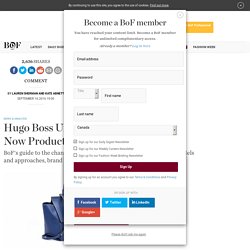
“I think now is the perfect time for Boss to offer new and exciting products to our consumers directly at the time they see it," Jason Wu, artistic director of Boss Womenswear, told BoF. "We are becoming even more retail driven and it makes sense to have a more customised experience in our stores and on hugoboss.com.” Michael Kors Takes A 'Hybrid' Approach to Fashion Immediacy (14 September 2016) Michael Kors Autumn/Winter 2016 | Source: Indigital. Reiss And Ted Baker Are Growing UK Retailers Marketing Essay. Introduction The buying process relies on a wide range of information, which must be researched, analysed and evaluated to achieve a focused merchandise plan.
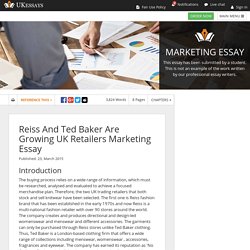
Therefore, the two UK trading retailers that both stock and sell knitwear have been selected. The first one is Reiss fashion brand that has been established in the early 1970s and now Reiss is a multi-national fashion retailer with over 90 stores around the world. Top Ten Ethical Issues in a Fashion Business. The fashion industry has complex connections to many other fields, including manufacturing, advertising, production of raw materials, transportation and retailing. The tremendous profits that stand to be made in the fashion industry create the temptation to engage in unethical behavior.
When producers, manufacturers, models or consumers are being exploited or treated unfairly, fashion executives have an ethical responsibility to change the situation. Body Image Virtually all of the models who represent fashion houses are abnormally thin, in keeping with the perceived aesthetic preferences of the public. This focus on extreme thinness in women has been blamed for eating disorders and poor body image among some women whose bodies don't conform to this idealized image. Has the "death of the high street" been exaggerated? New studies published today have found that UK consumers still opt for physical shopping destinations and suggest “the death of the high street” has been exaggerated.
A report by The Markey Creative has found that 75 per cent of consumers surveyed would not abandon the high street for online shopping. Nearly half of consumers preferred to get a feel for the products they were purchasing and nearly a quarter said they enjoyed the social aspect of shopping. A further 88 per cent said staff were important to the shopping experience. The rise of the high-end street: Zara, Whistles and Cos pioneer a new age for our high-street. UK fashion industry statistics. How Whistles Reemerged as One of the Most Exciting Contemporary Brands in Fashion. 2008 was not an easy year for many in the fashion industry -- least of all, perhaps, for Jane Shepherdson. The former Topshop brand director, once described as "the most powerful woman on the high street," had just become chief executive of (and a substantial investor in) a fading British brand called Whistles.
Ted Baker growing into global fashion brand. Great Brands Don’t Follow Trends, They Create Them. 16356. Worldwide Retail Ecommerce Sales Will Reach $1.915 Trillion This Year - eMarketer. In 2016, total retail sales across the globe will reach $22.049 trillion, up 6.0% from the previous year. eMarketer estimates sales will top $27 trillion in 2020, even as annual growth rates slow over the next few years, as explored in a new eMarketer report, “Worldwide Retail Ecommerce Sales: The eMarketer Forecast for 2016” (eMarketer PRO customers only). eMarketer includes sales across all retail channels in its estimates for total retail sales. This includes sales from ecommerce retailers and transactions that occur over consumer-to-consumer (C2C) platforms such as eBay and other auction sites; and sales by motor vehicle and parts dealers and by gas stations. Travel, event ticket and restaurant sales are excluded from eMarketer’s forecast. eMarketer has lowered its projections for overall retail sales since its previous forecast in December 2015, mainly due to low oil prices and negative currency effects.
eMarketer PRO customers can view the full report here. Fast fashion, "value" fashion. Fast fashion, "value" fashion ‘We now buy 40% of all our clothes at value retailers, with just 17% of our clothing budget.’ TNS Worldpanel (2006) Fashion Focus issue 29 A Cambridge University study reports that in 2006, people were buying a third more clothes than they were in 2002, and women have four times as many clothes in their wardrobe than they did in 1980. How Brexit may affect the British fashion industry. Are ‘See Now, Buy Now’ Shows Driving Sales? LONDON, United Kingdom — The fashion industry’s “see now, buy now” experiment is underway.